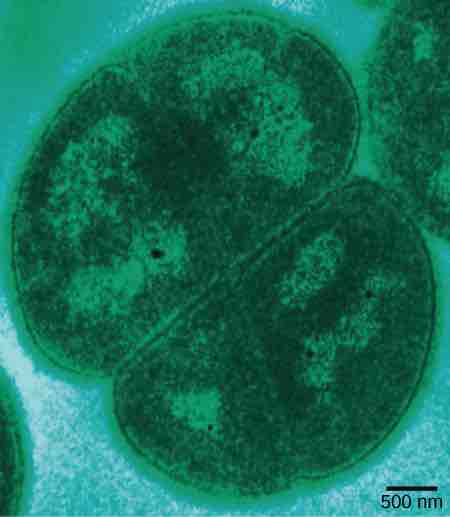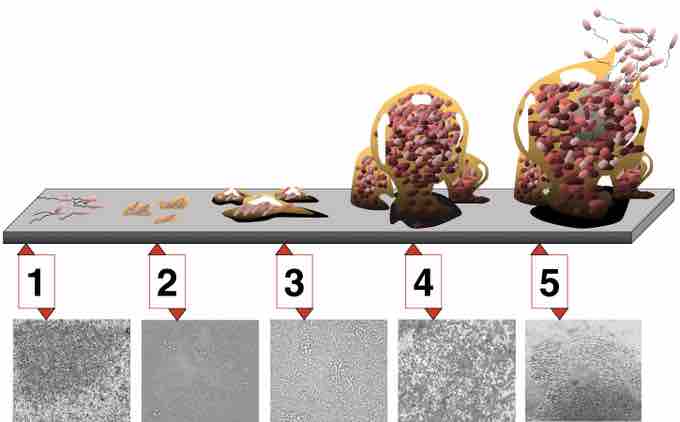Microbes Are Adaptable: Life in Moderate and Extreme Environments
Some organisms have developed strategies that allow them to survive harsh conditions. Prokaryotes thrive in a vast array of environments; some grow in conditions that would seem very normal to us, whereas others are able to thrive and grow under conditions that would kill a plant or animal. Almost all prokaryotes have a cell wall: a protective structure that allows them to survive in both hyper- and hypo-osmotic conditions. Some soil bacteria are able to form endospores that resist heat and drought, thereby allowing the organism to survive until favorable conditions recur. These adaptations, along with others, allow bacteria to be the most abundant life form in all terrestrial and aquatic ecosystems.
Other bacteria and archaea are adapted to grow under extreme conditions and are called extremophiles, meaning "lovers of extremes." Extremophiles have been found in all kinds of environments: the depth of the oceans, hot springs, the Arctic and the Antarctic, in very dry places, deep inside earth, in harsh chemical environments, and in high radiation environments, just to mention a few . These organisms give us a better understanding of prokaryotic diversity and raise the possibility of finding new prokaryotic species that may lead to the discovery of new therapeutic drugs or have industrial applications. Because they have specialized adaptations that allow them to live in extreme conditions, many extremophiles cannot survive in moderate environments. There are many different groups of extremophiles. They are identified based on the conditions in which they grow best. Several habitats are extreme in multiple ways. For example, a soda lake is both salty and alkaline, so organisms that live in a soda lake must be both alkaliphiles and halophiles. Other extremophiles, like radioresistant organisms, do not prefer an extreme environment (in this case, one with high levels of radiation), but have adapted to survive in it.

Bacteria and radiation tolerance
Deinococcus radiodurans, visualized in this false color transmission electron micrograph, is a prokaryote that can tolerate very high doses of ionizing radiation. It has developed DNA repair mechanisms that allow it to reconstruct its chromosome even if it has been broken into hundreds of pieces by radiation or heat.
Prokaryotes in the Dead Sea
One example of a very harsh environment is the Dead Sea, a hypersaline basin that is located between Jordan and Israel. Hypersaline environments are essentially concentrated seawater. In the Dead Sea, the sodium concentration is 10 times higher than that of seawater. The water also contains high levels of magnesium (about 40 times higher than in seawater) that would be toxic to most living things. Iron, calcium, and magnesium, elements that form divalent ions (Fe2+, Ca2+, and Mg2+), produce what is commonly referred to as "hard" water. Taken together, the high concentration of divalent cations, the acidic pH (6.0), and the intense solar radiation flux make the Dead Sea a unique, and uniquely hostile, ecosystem .

Halophile habitats
(a) The Dead Sea is hypersaline. Nevertheless, salt-tolerant bacteria thrive in this sea. (b) These halobacteria cells can form salt-tolerant bacterial mats.
The Ecology of Biofilms
Until a couple of decades ago, microbiologists used to think of prokaryotes as isolated entities living apart. This model, however, does not reflect the true ecology of prokaryotes, most of which prefer to live in communities where they can interact. A biofilm is a microbial community held together in a gummy-textured matrix that consists primarily of polysaccharides secreted by the organisms, together with some proteins and nucleic acids. Biofilms grow attached to surfaces. Some of the best-studied biofilms are composed of prokaryotes, although fungal biofilms have also been described, as well as some composed of a mixture of fungi and bacteria.

Biofilm Development
Five stages of biofilm development are shown. During stage 1, initial attachment, bacteria adhere to a solid surface via weak van der Waals interactions. During stage 2, irreversible attachment, hairlike appendages called pili permanently anchor the bacteria to the surface. During stage 3, maturation I, the biofilm grows through cell division and recruitment of other bacteria. An extracellular matrix composed primarily of polysaccharides holds the biofilm together. During stage 4, maturation II, the biofilm continues to grow and takes on a more complex shape. During stage 5, dispersal, the biofilm matrix is partly broken down, allowing some bacteria to escape and colonize another surface. Micrographs of a Pseudomonas aeruginosa biofilm in each of the stages of development are shown.
Biofilms are present almost everywhere: they can cause the clogging of pipes and readily colonize surfaces in industrial settings. In recent, large-scale outbreaks of bacterial contamination of food, biofilms have played a major role. They also colonize household surfaces, such as kitchen counters, cutting boards, sinks, and toilets, as well as places on the human body, such as the surfaces of our teeth.
Interactions among the organisms that populate a biofilm, together with their protective exopolysaccharidic (EPS) environment, make these communities more robust than free-living, or planktonic, prokaryotes. The sticky substance that holds bacteria together also excludes most antibiotics and disinfectants, making biofilm bacteria hardier than their planktonic counterparts. Overall, biofilms are very difficult to destroy because they are resistant to many common forms of sterilization.